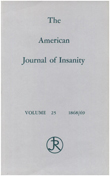Treatment of panic disorder with agoraphobia: comparison of fluvoxamine, placebo, and psychological panic management combined with exposure and of exposure in vivo alone
Abstract
OBJECTIVE: The purpose of this comparative outcome study was to investigate whether the effects of exposure in vivo treatment for panic disorder with agoraphobia could be enhanced by adding interventions specifically for panic attacks before the start of exposure treatment. The additional effect of two types of treatment for panic attacks-- pharmacological (fluvoxamine) and psychological (repeated hyperventilation provocations and respiratory training)--was examined. Thus, the combined treatment of panic interventions with exposure in vivo could be compared to exposure in vivo alone. METHOD: Ninety-six patients were randomly assigned to four treatment conditions: double- blind, placebo-controlled fluvoxamine followed by exposure in vivo, psychological panic management followed by exposure, and exposure in vivo alone. Outcome was assessed by self-report measures, a standardized multitask behavioral avoidance test, and continuous monitoring of panic attacks. Seventy-six patients completed the study. RESULTS: All four treatments were effective and resulted in a significant decrease of agoraphobic avoidance. Moreover, the combination of fluvoxamine and exposure in vivo demonstrated efficacy superior to that of the other treatments and had twice as large an effect size (difference between pre- and posttreatment scores) on self- reported agoraphobic avoidance. The other treatments did not differ among each other in effectiveness. CONCLUSIONS: Results of the study indicate that the short-term outcome of exposure in vivo treatment can be enhanced by adding fluvoxamine treatment. Psychological panic management combined with exposure was not superior to exposure alone of equal duration.
Access content
To read the fulltext, please use one of the options below to sign in or purchase access.- Personal login
- Institutional Login
- Sign in via OpenAthens
- Register for access
-
Please login/register if you wish to pair your device and check access availability.
Not a subscriber?
PsychiatryOnline subscription options offer access to the DSM-5 library, books, journals, CME, and patient resources. This all-in-one virtual library provides psychiatrists and mental health professionals with key resources for diagnosis, treatment, research, and professional development.
Need more help? PsychiatryOnline Customer Service may be reached by emailing [email protected] or by calling 800-368-5777 (in the U.S.) or 703-907-7322 (outside the U.S.).



